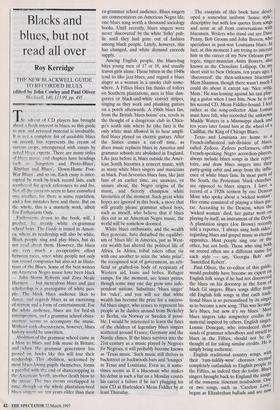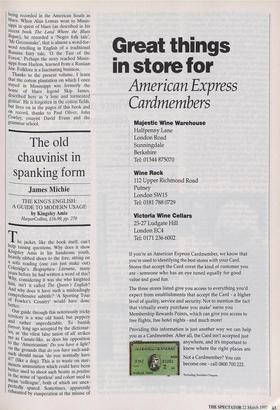Blacks and blues, but not read all over
Roy Kerridge
THE NEW BLACKWELL GUIDE TO RECORDED BLUES edited by John Cowley and Paul Oliver Ric!, kiwi/ f40, f13.99, pp. 495 The advent of CD players has brought about a fresh interest in blues, so this guide to new and reissued material is invaluable. It is not a complete list of available blues on record. but represents the cream of various crops, interspersed with essays by noted blues experts. There are many styles of bfue.s music. and chapters have headings such as Songsters and Proto-Blues', 'Rhythm and Blues', Down-Home Post- War Blues', and so on. Each essay is inter- rupted by track-by-track record lists, each n'imhcred for quick references to and fro. Not All the essayists seem to have consulted one another, for there is some repetition, and a few mistakes here and there. But on the whole, this is a masterly work, albeit For Fnthusiasts Only.
Futhosiasts drawn to the book, will, I predict be mainly white ex-grammar school boys. The Guide is issued in Ameri- ca. where its readership will also be white. Black people sing and play blues, but do not read about them. However, the blues are very much a co-operative effort between races. since white people not only run record companies but also act as Histo- rians of the Blues. Some of the best writers on American Negro music have been black -- John Storm Roberts and Zora Neale Hurston --- but meticulous blues and jazz scholarship is a prerogative of white peo- ple. The black blues audience likes to dance, and regards blues as an exorcising of sorrow and a form of entertainment. For the white audience, blues are for bed-sit introspection. and a grammar school obses- siveness seems to accompany the music. Without such obsessiveness, however, blues history would he unwritten.
Abolition of the grammar school came as a blow to blues and folk music in Britain, and when the grammar generation has passed on, books like this will lose their readership. This abolition, welcomed by most blues-loving pupils themSelves, forms a parallel with the end of sharecropping in the American South, another death blow to the music. The two events overlapped in time. though on-the whole plantation-bred blues singers are ten years older than their ex-grammar school audience. Blues singers are commentators on American Negro life, one blues song worth a thousand sociology books. Until recently, blues singers were never 'discovered' by the white 'folky' pub- lic until they had gone out of fashion among black people. Lately, however, this has changed, and white demand exceeds supply.
Among English people, the blues-bug bites young men of 17 or 18, and usually leaves girls alone. Those bitten in the 1940s tend to like ja77-blues, and regard a blues singer as a woman in a smoky club some- where. A Fifties blues fan thinks of toilers on Southern plantations, men in blue dun- garees or black-and-white convict stripes, singing as they work and plunking guitars on a porch afterwards. A 1960s blues fan, from the British 'blues boom' era, revels in the thought of a dangerous club in Chica- go's south side where he (the fan) is the only white man allowed in to hear ampli- fied blues played on electric guitars. After the Sixties comes a cut-off time, as disco music replaces blues in America and grammar schools are abolished in England. Like jazz before it, blues outside the Amer- ican South becomes a concert music, with as many white blues singers and musicians as black. Post-Seventies blues fans, like jazz fans of an earlier time, are unaware, or unsure about, the Negro origins of the music, and fiercely champion white favourites of the moment. Such great white hopes are ignored in this book, a move that will greatly please grammar school boys, such as myself, who believe that if blues dies out as an American Negro music, the world will be somehow doomed.
White blues enthusiasts, and the wealth they generate, have disturbed the equilibri- um of 'blues life' in America, just as West- ern wealth has altered the political life of Africa. In Africa, tribal rulers often vie with one another to seize the 'white prize', the recognised seat of government, an arti- ficial or grafted-on body of recipients of Western aid, loans and bribes. Refugee camps, for the moment, are lesser prizes, though some may one day grow into inde- pendent nations. Substitute 'blues singer' for 'ruler', and you will see that white wealth has become the prize for a success- ful blues singer, who ceases to represent his people as he dashes around from Berkeley to Berlin, via Norway or Sweden if possi- ble. I would be interested to learn the fates of the children of legendary blues singers scattered around France, Germany and the Nordic climes. If the blues survives into the 21st century as a music played by Negroes for Negroes, it will probably become known as 'Texas music.' Such music still thrives in backstreet or backwoods bars and 'lounges' in Texas and Louisiana. Even so, it some- times seems as if a bluesman who makes his debut in such a bar on a Monday counts his career a failure if he isn't plugging his new CD at Hariesden's Mean Fiddler by at least Thursday. The essayists of this book have devel- oped a somewhat uniform 'house style, descriptive but with few quotes from songs and none at all from conversations with bluesmen. Writers who stand out are Dave Penny, Bob Groom and John Broven, who specialises in post-war Louisiana blues. In fact, at this moment I am trying to interest him in the career of my New Orleans pro- tegee, singer-musician Anita Bowers, also known as the Chocolate Lollipop. On my short visit to New Orleans, ten years ago, I `discovered' the then-unknown bluesman Mem Shannon, though there wasn't much I could do about it except say 'Nice song, Mem.' He was leaning against his taxi play- ing a guitar when I met him. Now he is on his second CD, Mean Fiddler-bound. I feel rather as the song-collector Alan Lomax must have felt, who recorded the unknown Muddy Waters in a Mississippi shack and ten years later found him at the wheel of a Cadillac, the King of Chicago Blues.
Texas and Louisiana are home to a French-influenced sub-division of blues, called Zydeco. Zydeco performers, often French-speaking Negro accordion-players, always include blues songs in their reper- toire, and draw blues singers into their party-going orbit and away from the influ- ence of white blues fans. In most parts of the South, the Protestant 'black churches are opposed to blues singers. I have a record of a 1920s sermon by one Deacon Mose who spoke about a 'wicked woman: Her crime consisted of playing a blues gui- tar. According to the Deacon, when the `wicked woman' died, her guitar went on playing by itself, an instrument of the Devil. A plantation singer (Joe Brown) recently q told a reporter, 'I always sang both sides', regarding blues and gospel music as eternal opposites. Most people sing one or the other, but not both. Those who sing both on record often use a different name for each style — say, 'Georgia Bob' and `Sanctified Robert'.
Paul Oliver, the co-editor of this guide, would probably have become an expert orl, English folk songs if he had not discovered the blues on his doorstep in the form of black GI singers. Blues songs differ from old English folk songs in that each tradi- tional blues is so personalised by its singer as to become a new song. 'This was So-and- So's blues, but now it's my blues.' Most blues singers take songwriter credits for material inspired by others. English singer, Lonnie Donegan, who introduced thou- sands of grammar schoolboys and myself to blues in the Fifties, should not be ill" thought of for taking similar credits. He Is simply being authentic. English traditional country songs, with, their `rum-tiddily-wow' choruses seemed completely outlandish to English people 111 the Fifties, as indeed they do today. Blues singers brought back to England the image of the romantic itinerant troubadour. One or two songs, such as 'Careless Love began as Elizabethan ballads and are now being recorded in the American South as blues. When Alan Lomax went to Missis- sippi in quest of blues (as described in his recent book The Land Where the Blues Began), he recorded a 'Negro folk tale', Mr Greensnake', that is almost a word-for- word retelling in English of a traditional Russian fairy tale, '0 the Tsar of the Forest.' Perhaps the story reached Missis- sippi from Harlem, learned from a Russian Jew. Folklore is a fascinating business.
Thanks to the present volume, I learn that the cotton plantation on which I once stayed in Mississippi was formerly the home of blues legend Skip James, described here as 'a lone and tormented genius'. He is forgotten in the cotton fields, but lives on in the pages of this book and on record, thanks to Paul Oliver, John Cowley, essayist David Evans and the grammar school.



































































 Previous page
Previous page